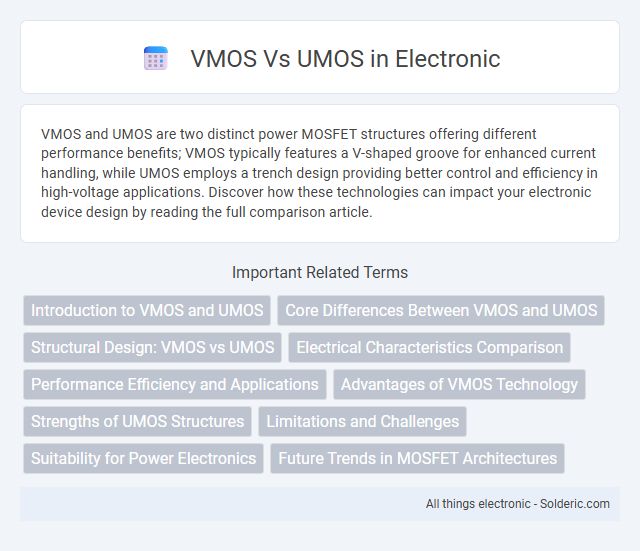VMOS and UMOS are two distinct power MOSFET structures offering different performance benefits; VMOS typically features a V-shaped groove for enhanced current handling, while UMOS employs a trench design providing better control and efficiency in high-voltage applications. Discover how these technologies can impact your electronic device design by reading the full comparison article.
Comparison Table
| Feature | VMOS | UMOS |
|---|---|---|
| Operating System Type | Android-based virtual machine | Lightweight mobile OS variant |
| Primary Use | Run multiple Android environments simultaneously | Optimized for fast, efficient mobile use |
| Virtualization Support | Yes, supports Android app sandboxing | No, native OS without virtualization |
| User Interface | Customizable Android interface | Minimalistic, streamlined UI |
| App Compatibility | Supports most Android apps within VM | Supports native and lightweight apps |
| Resource Usage | Higher, due to running virtual machines | Lower, optimized for performance |
| Security | Isolated virtual environments improve security | Focus on native security features |
Introduction to VMOS and UMOS
VMOS is a virtual machine operating system that enables running multiple Android instances simultaneously on a single device, providing enhanced multitasking and app compatibility. UMOS, a microkernel-based operating system, emphasizes security, modularity, and efficient resource management for embedded and mobile platforms. Both VMOS and UMOS cater to different user needs, with VMOS focusing on Android virtualization and UMOS targeting high-performance, secure microkernel architectures.
Core Differences Between VMOS and UMOS
VMOS operates as a virtual machine on Android devices, allowing users to run a second instance of Android with root access and separate system resources, whereas UMOS is designed as a lightweight, standalone operating system optimized for performance and energy efficiency. VMOS supports app cloning and sandboxing for enhanced multitasking and testing environments, while UMOS emphasizes streamlined user experience and stability without virtualization overhead. The core difference lies in VMOS's virtualization approach enabling dual OS functionality versus UMOS's native OS design focusing on optimized hardware utilization.
Structural Design: VMOS vs UMOS
VMOS and UMOS transistors differ significantly in structural design, impacting their electrical performance and applications. VMOS features a V-shaped groove in the gate region, which enhances electron mobility and allows for higher current density, making it ideal for power applications. UMOS, or U-shaped MOSFET, incorporates a U-shaped trench that improves surface area for channel formation, reducing on-resistance and enabling better thermal conductivity and device efficiency in high-frequency switching environments.
Electrical Characteristics Comparison
VMOS transistors exhibit lower on-resistance and faster switching speeds compared to UMOS devices due to their vertical channel structure. UMOS devices, featuring a trench gate design, provide better control over avalanche breakdown voltage and reduced gate charge, enhancing high-voltage performance. The choice between VMOS and UMOS depends on the specific application requirements for power efficiency, switching frequency, and voltage handling capabilities.
Performance Efficiency and Applications
VMOS offers higher performance efficiency due to its ability to run a full-fledged Android OS on virtual machine technology, allowing seamless multitasking and smoother app operations compared to UMOS. UMOS, designed primarily as a lightweight virtual machine, optimizes resource usage but may lag in handling intensive applications or gaming. VMOS suits developers and users needing robust app testing environments, whereas UMOS is ideal for basic virtualization tasks with limited hardware resources.
Advantages of VMOS Technology
VMOS technology offers enhanced mobility and flexibility compared to UMOS, enabling more efficient power management in high-frequency applications. It provides lower on-resistance and faster switching speeds, which improves energy efficiency and reduces heat dissipation in power devices. These advantages make VMOS highly suitable for use in compact, high-performance electronics such as RF amplifiers and power converters.
Strengths of UMOS Structures
UMOS structures offer superior electron mobility due to their unique channel formation, enhancing the switching speed and reducing power consumption in high-frequency applications. Their lateral design provides better scalability and reliability for integrated circuits, making UMOS ideal for power device applications. You can rely on UMOS technology for efficient thermal management and increased durability in demanding electronic environments.
Limitations and Challenges
VMOS faces limitations such as higher resource consumption and instability on certain devices due to its virtual machine-based architecture, which can cause lag and compatibility issues with resource-intensive apps. UMOS encounters challenges in achieving efficient performance since its microkernel design may limit hardware access, impacting system speed and application support. Your choice depends on balancing VMOS's broader compatibility with UMOS's security advantages despite these inherent constraints.
Suitability for Power Electronics
VMOS transistors offer high electron mobility and low on-resistance, making them ideal for high-frequency power electronics and efficient switching applications. UMOS devices provide superior voltage handling and ruggedness, which enhances reliability in high-voltage power converters and industrial power systems. Your choice depends on whether you prioritize switching speed and efficiency (VMOS) or voltage tolerance and durability (UMOS) in your power electronics design.
Future Trends in MOSFET Architectures
Future trends in MOSFET architectures highlight a shift from traditional VMOS (V-groove MOS) and UMOS (U-groove MOS) designs towards more advanced structures like FinFETs and Gate-All-Around (GAA) transistors, aiming to enhance scalability and reduce short-channel effects. VMOS devices offer high electron mobility due to their vertical channel design, but UMOS architectures improve reliability and manufacturing efficiency with flatter channel profiles. Emerging research focuses on integrating nanoscale MOSFETs with novel materials such as silicon carbide and gallium nitride to push performance limits in power electronics and high-frequency applications.
VMOS vs UMOS Infographic

 solderic.com
solderic.com